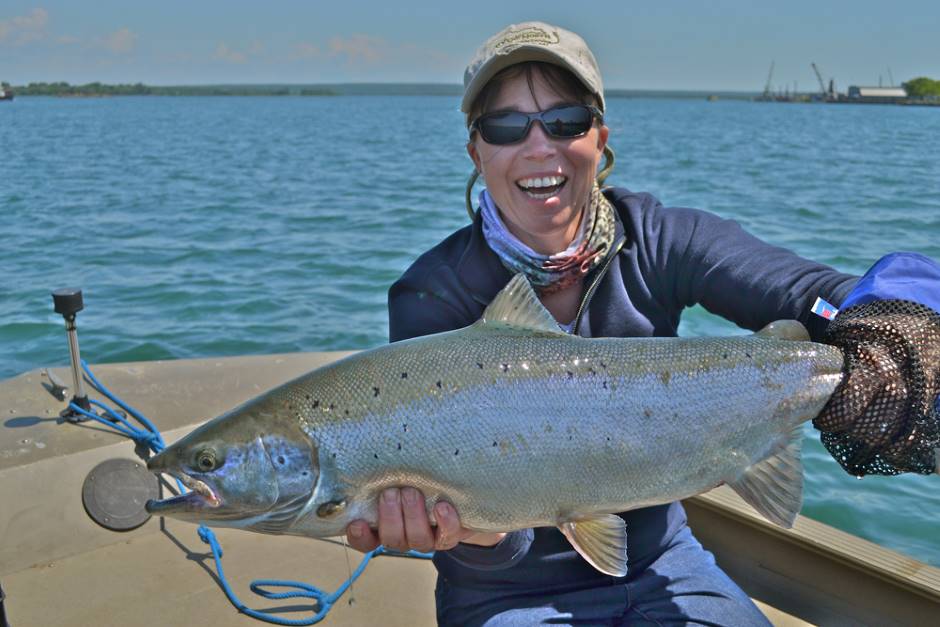St. Marys River’s Atlantic salmon among the ‘hardest fighting fish in the Great Lakes’
Anglers from all over the world come to the St. Marys River between lakes Superior and Huron to chase a fish that isn’t really even supposed to be there: Atlantic salmon.
This fish are there thanks to a decades-long stocking effort by Lake Superior State University. And the anglers are there because the fish are worth the trip.
“The silver ‘new arrival’ fish — those are some of the hardest fighting fish in the Great Lakes, that’s for sure,” said Brad Petzke, charter captain with Rivers North Guide Service in Marquette, Michigan.
The silver fish are now fading as they spawn through November, but they’ll hang around throughout the winter before dropping back into Lake Huron in May and June. Then the next batch — fresh from a year off of spawning spent bulking up in the big lake — will start their migration upriver.
“Essentially, you can catch Atlantics in this river 365 days a year,” Petzke said.
The mix of habitat and flexibility of the Atlantic salmon’s diet makes for “several tons” of different techniques and fishing opportunities on the St. Marys, Petzke said. The St. Marys rapids, accessed from the Canadian side, is open to wading anglers when the water levels are safe. The rest of the river averages 10 to 20 feet of water and requires a boat. Much of the fishing goes down behind hydroelectric plants, Petzke said.
When the fish first push up the river in late June, the river’s still-cold water holds a variety of baitfish, including smelt and juvenile salmon and steelhead. Petzke, primarily a fly fisherman, says that’s a great time for streamer fishing, stripping baitfish imitations that producing exciting takes.

One of Petzke’s clients appears satisfied with this particular Atlantic salmon from the St. Marys River. (Credit: Rivers North Guide Service)
As the water warms and the baitfish move out of the river, the insect activity heats up. The Atlantics key in on midges, caddis flies and the region’s famous and prolific hatch of giant Hexagenia mayflies. Fishing nymphs under an indicator is productive once the bug bite turns on.
“The Atlantic salmon are a very opportunistic fish,” Petzke said. “That’s why they’re doing so well in Lake Huron.”
The Michigan Department of Natural Resources is banking on that success after the Lake Huron Chinook salmon fishery collapsed in the mid-2000s and took much of the angling business with it. The DNR is rearing Atlantic salmon in its own hatcheries and stocking them in several Lake Huron tributaries, including the Thunder Bay and Au Sable rivers. The hope is those fish will create more opportunities in both the big lake and in the rivers when they return to spawn.
The state says it’s too soon to say whether the program is working, but with any luck they’ll see some of the same success as the Lake Superior State University program. LSSU stocks an average of 30,000 fish a year and sees 6 to 8 percent of those end up in anglers’ creels. That’s well above the 2 percent rate state biologists consider “good.”
After decades of raising and stocking Atlantic salmon in the St. Marys River, the university lab has cultivated a unique brood stock, according to Stefan Tucker, a former LSSU student now with the DNR. Fish from that stock thrive in the river, Lake Huron and sometimes beyond.
“There are random fish that have been found all over the Great Lakes,” Tucker said. “Every single one of the Great Lakes. Every side, every corner of the Great Lakes.”
Meanwhile, those that return to the St. Marys are good enough for Petzke, who does more than half of his guiding on the river.
“Every year I fish here more, too,” he said.

0 comments